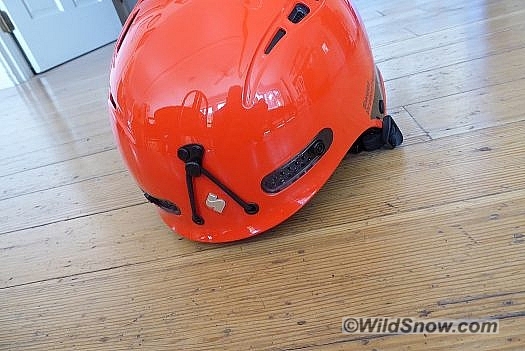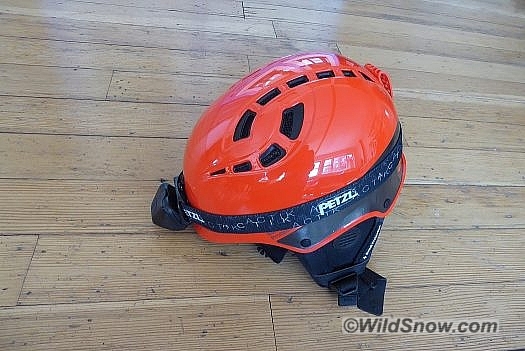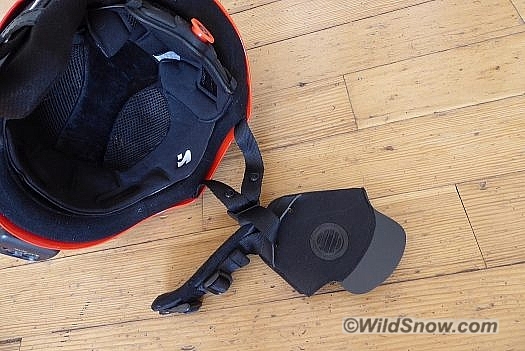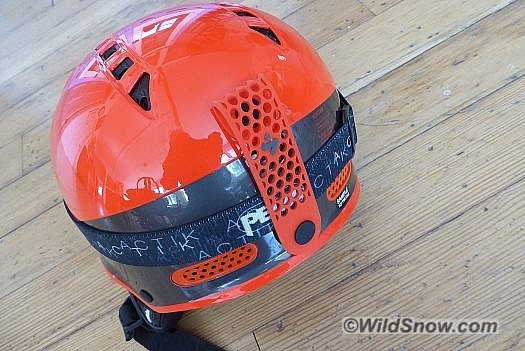Next level? The Sweet Protection Igniter Alpiniste 2 is indeed dual certified as both a snowsports and climbing hardhat. In our view that’s the minimum level you want for a ski touring helmet, as none of the typical human-powered sports helmets in present retail offer much protection. They’re more along the lines of something psychological — so you might as well sport the most “certified” you can. Which unless you abuse your neck muscles sporting a motorsports hat, is a dual certified snowsports/mountaineering option. (Dual certification is easy to ascertain. It’s usually stated in the product specifications, as well as a tag attached to the inside of the helmet.)
Thus, in regards to actual protection of your noggin, I’d call the Igniter as good as one can expect, but nothing that obviously exceeds other brands with dual certifications. Where the “next level” comes in is the overall detail and design. Beautiful. More on that later, first, my usual rant.
When I searched the Igniter specs for anything that indicated it might exceed protection standards, the words “optimized impact distribution” were used. In my opinion, just about any helmet you can get does an adequate job of “impact distribution.” In fact, the bugbear of “impact distribution” is what constantly confuses the normal helmet-consuming shopping public. Normal being defined as most of us, including myself. What you want in a helmet is impact or shock *absorption* along with attenuated deceleration of your head during an impact. Let me repeat: Disabuse yourself of the “distribution” concept. Any helmet does plenty of “distribution.” A thick bouffant head of hair mixed with an entire can of hairspray provides “distribution.” A helmet needs to “absorb” and “soften.”
Don’t get me wrong here, Sweet Protection Igniter clearly fits the “best” category in terms of ski helmet protection. It’s just that we’d like to see helmets that significantly exceed “best.”
Moving along, Sweet Protection does do an exceptional job with their feature set… Let me count the ways.
1. As I alluded to above, the shell molding on this guy is right up there with any award-winning industrial design you can find.
2. Commodious ventilation comprises a set of vents at the rear, numerous openings on top, and operable brow/goggle vents at the front. The crown vents are not operable, thus requiring a helmet compatible jacket hood if you’re sporting under rain or wet snowfall.
3. One of the few dual certified helmets available with a front headlamp mount. Consisting of a triangular bungee, I found this to be useful but not entirely effective for ski touring, depending on the model and shape of the headlamp. B+ for effort.
4. Easily removable ear flaps convert the hat to warm weather “summer” mode. Best! of any helmet I’ve tried.
5. Audio ready — fill those ear flaps with speakers so you can’t hear those pesky avalanches.
6. Turn dial fit at rear is state-of-art, excellent integration with liner.

Front headlamp mounting bungee. Effectiveness depends on shape of headlamp. I ended up combining with a bit of hook-loop.
Weight: 620 grams, size medium with ear flaps. That’s significantly heavier (6 ounces!) than a dual certified competitor clocking at 442 grams. My guess is that Sweet Protection ABS shell adds the weight, hard to know for certain without irreversible dissection. I have to question if that ~28% increase in helmet mass results in a 28% increase in energy absorption or 28% slowing of impact deceleration. Highly doubtful. (Deconstruction could happen, stay tuned.) Further, one might contend a beefier shell could help the helmet remain viable through days and weeks of repeated impacts. Not so. My understanding is one should consider binning a helmet after one, repeat one severe impact — visible damage or not.
Conclusions: Sweet Protection positions themselves at a premium helmet maker. The Igniter we have in our studio is indeed a stunning example of manufacturing excellence. From the injection molding details of the ABS shell, to liner hook/loop that actually remains attached where intended (instead of pulling out when you remove the liner), I’m delighted by this stunning statement of industrial design. The lack of MIPS could be a concern, though bear in mind that MIPS can be a costly and weight increasing “feature” offering perhaps a minimal increase in protection (wearing a hat under your helmet might actually have the same effect). With an obvious weight penalty, this helm probably offers as much protection as any other brand’s dual certified models, only with the best features and finish we’ve yet seen in a ski touring hardhat.
WildSnow.com publisher emeritus and founder Lou (Louis Dawson) has a 50+ years career in climbing, backcountry skiing and ski mountaineering. He was the first person in history to ski down all 54 Colorado 14,000-foot peaks, has authored numerous books about about backcountry skiing, and has skied from the summit of Denali in Alaska, North America’s highest mountain.



